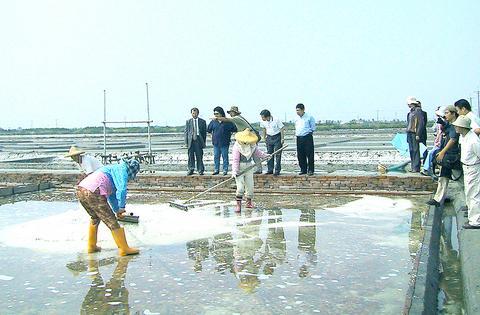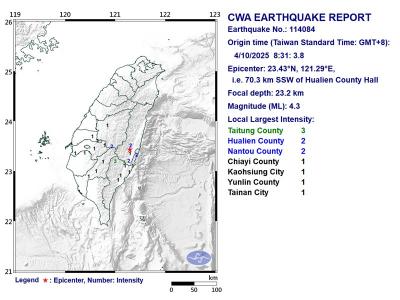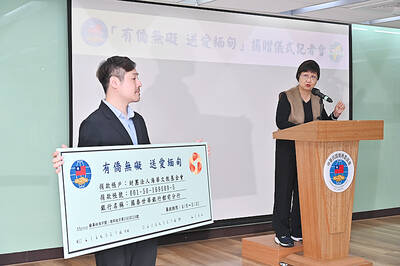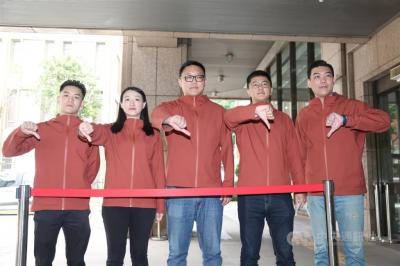Wang He-nan (王河南), a 70-year-old grandfather of five, was born in An-shun (安順), Tainan City. Anshun used to be a village known for its 500-hectare stretch of salt fields. Wang had been helping out in the fields since he was 12; to him, making salt was his life.
In the early 1990s, the traditional method of producing salt manually became obsolete. Furthermore, due to the founding of Tainan Technology Industrial Park in 1991 and the establishment of Szu-tsao Wildlife Protection in the area, Anshun's survival was threatened as the salt plantation was cut down to 300 hectares. By 1994, the salt operations came to an end and Wang was thrown into a panic as his source of making a living had disappeared.
Since then, he had been doing odd jobs, like manufacturing hair clips. Wang could barely make ends meet as his daily wage averaged about NT$200 per day. In June last year, the residents of Anshun were forced to relocate while a team of volunteers stepped in to preserve remaining salt-making sites.

PHOTOS: CODY YIU, TAIPEI TIMES, AND TSAI WEN-PIN, TAIWAN FIELD F
This team of volunteers was led by Kun Shan University of Technology lecturer Lu Chien-ming (盧建銘), who named the volunteer group Taiwan Field Factory, a non-profit organization which aims to reconstruct ecological and archaeological sites in Anshun under the guidance of the Council of Agriculture (COA).
During the period of data research, the group came across Wang and asked for his assistance in data collection. Wang was then hired by Lu's team as a temporary worker and he was assigned to cut grass. After studying the information about former salt fields, Lu's team was inspired to revive the trade that was established in 1919 during the Japanese administration.
In April, Lu's team finally received funding from multiple government administrations, the Council of Labor Affairs (CLA), the COA and the Tainan City Government, as well as donations from the private sector.

After the budget had been approved, the revival program was officially on the road and the salt field area is now known as Salt-Pan Eco-Village. The village is part of a greater scheme -- a cultural village tourism project. It consists of multiple societal, ecological and economical divisions such as Red Forest, a bird habitat area and arts and crafts workshops.
Fifteen former Anshun residents were invited to return to the salt fields. Seven who were experienced in salt making work on the fields, while the other eight are in charge of maintaining the warehouse and irrigation system. Today, the new salt plantation covers 5ha.
Each individual worker works a maximum of 176 hours per month and gets paid NT$95 per hour by the CLA's Well-Rounded Job Development Program.
However, Wang and another worker, who are both over the age 65, do not qualify to receive their wages directly from the CLA due to a senior citizen regulation. Lu, who fought to keep these two experienced saltworkers, decided to pay them out of his own pocket.
Wang acts as the field team leader and his major responsibility is assigning tasks to his co-workers every morning, as well as assisting in the day-to-day operation of the fields. The team starts their day at 7am, gets a rest between 11am and 1pm and works until 5pm.
"For almost 10 years, I could not work on my salt fields and did not have a permanent job -- life was tough then. Thanks to the revival and job development programs, I am now able to get paid to do what I love to do. I am glad to be back to making salt again," Wang said.
The revival program consists of two stages -- societal and economical. From April to January next year, the program is going through the societal stage, where the focus is on rebuilding the salt-making community.
"We are hoping to transform into the economic stage next January, meaning that we will start selling the salt and make a profit," said Tsai Wen-pin (蔡文彬),a member of the field factory and a student of the Department of Architecture and Archaeological Preservation at Shu-Te University.
Tsai said that the unrefined salt produced by the traditional method may be used in preserving fish and plums.
"Next year, we are hoping to sell our salt to plum producers in Mei-shan, a village in Chiayi County which is famous for its plums. In the past, this kind of unrefined but organic salt was used for flavoring; however, today, unrefined salt is replaced by industrial salt," Tsai said.
In addition, salt produced in An-shun can also be sold as souvenirs.
"We are hoping to package the salt into souvenirs, such as amulets containing salt, which are popular in Japan," said Hsu Yang-ming (許陽明), deputy mayor of Tainan. Hsu further stated that the cultural village is expected to be officially opened by the end of this year.
So far, the salt-making project has been very successful, as the area serves many purposes. It fulfills the wish of former residents to return to the fields and also has high educational value as it is already a popular field-trip destination for school children and nature lovers.
"We are now working with the International Field School, the UN and the Sierra Club to promote awareness in the international arena of Taiwan's ecological environment," Lu said.
Hsu shared the same view.
"We are hoping to attract a good number of nature lovers and ecological experts from around the world in the future," Hsu said.
After visiting the salt fields on Thursday, CLA Chairperson Chen Chu (

Taiwan is stepping up plans to create self-sufficient supply chains for combat drones and increase foreign orders from the US to counter China’s numerical superiority, a defense official said on Saturday. Commenting on condition of anonymity, the official said the nation’s armed forces are in agreement with US Admiral Samuel Paparo’s assessment that Taiwan’s military must be prepared to turn the nation’s waters into a “hellscape” for the Chinese People’s Liberation Army (PLA). Paparo, the commander of the US Indo-Pacific Command, reiterated the concept during a Congressional hearing in Washington on Wednesday. He first coined the term in a security conference last

A magnitude 4.3 earthquake struck eastern Taiwan's Hualien County at 8:31am today, according to the Central Weather Administration (CWA). The epicenter of the temblor was located in Hualien County, about 70.3 kilometers south southwest of Hualien County Hall, at a depth of 23.2km, according to the administration. There were no immediate reports of damage resulting from the quake. The earthquake's intensity, which gauges the actual effect of a temblor, was highest in Taitung County, where it measured 3 on Taiwan's 7-tier intensity scale. The quake also measured an intensity of 2 in Hualien and Nantou counties, the CWA said.

The Overseas Community Affairs Council (OCAC) yesterday announced a fundraising campaign to support survivors of the magnitude 7.7 earthquake that struck Myanmar on March 28, with two prayer events scheduled in Taipei and Taichung later this week. “While initial rescue operations have concluded [in Myanmar], many survivors are now facing increasingly difficult living conditions,” OCAC Minister Hsu Chia-ching (徐佳青) told a news conference in Taipei. The fundraising campaign, which runs through May 31, is focused on supporting the reconstruction of damaged overseas compatriot schools, assisting students from Myanmar in Taiwan, and providing essential items, such as drinking water, food and medical supplies,

Prosecutors today declined to say who was questioned regarding alleged forgery on petitions to recall Democratic Progressive Party (DPP) legislators, after Chinese-language media earlier reported that members of the Chinese Nationalist Party (KMT) Youth League were brought in for questioning. The Ministry of Justice Investigation Bureau confirmed that two people had been questioned, but did not disclose any further information about the ongoing investigation. KMT Youth League members Lee Hsiao-liang (李孝亮) and Liu Szu-yin (劉思吟) — who are leading the effort to recall DPP caucus chief executive Rosalia Wu (吳思瑤) and Legislator Wu Pei-yi (吳沛憶) — both posted on Facebook saying: “I